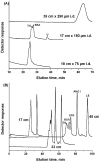Methacrylate Polymer Monoliths for Separation Applications
- PMID: 28773570
- PMCID: PMC5456823
- DOI: 10.3390/ma9060446
Methacrylate Polymer Monoliths for Separation Applications
Abstract
This review summarizes the development of methacrylate-based polymer monoliths for separation science applications. An introduction to monoliths is presented, followed by the preparation methods and characteristics specific to methacrylate monoliths. Both traditional chemical based syntheses and emerging additive manufacturing methods are presented along with an analysis of the different types of functional groups, which have been utilized with methacrylate monoliths. The role of methacrylate based porous materials in separation science in industrially important chemical and biological separations are discussed, with particular attention given to the most recent developments and challenges associated with these materials. While these monoliths have been shown to be useful for a wide variety of applications, there is still scope for exerting better control over the porous architectures and chemistries obtained from the different fabrication routes. Conclusions regarding this previous work are drawn and an outlook towards future challenges and potential developments in this vibrant research area are presented. Discussed in particular are the potential of additive manufacturing for the preparation of monolithic structures with pre-defined multi-scale porous morphologies and for the optimization of surface reactive chemistries.
Keywords: additive manufacturing; chromatography; methacrylate; microfluidics; monoliths; porous materials; stationary phase.
Conflict of interest statement
The authors declare no conflict of interest.
Figures















Similar articles
-
Recent strategies to enhance the performance of polymer monoliths for analytical separations.J Sep Sci. 2019 Apr;42(8):1564-1576. doi: 10.1002/jssc.201801126. Epub 2019 Mar 3. J Sep Sci. 2019. PMID: 30770635 Review.
-
Advances in monoliths and related porous materials for microfluidics.Biomicrofluidics. 2016 May 4;10(3):032901. doi: 10.1063/1.4948507. eCollection 2016 May. Biomicrofluidics. 2016. PMID: 27190564 Free PMC article. Review.
-
Current trends in the development of porous polymer monoliths for the separation of small molecules.J Sep Sci. 2016 Jan;39(1):51-68. doi: 10.1002/jssc.201501011. Epub 2015 Nov 3. J Sep Sci. 2016. PMID: 26420171 Review.
-
[Fabrication of nanomaterials incorporated polymeric monoliths and application in sample pretreatment].Se Pu. 2021 Mar;39(3):229-240. doi: 10.3724/SP.J.1123.2020.05030. Se Pu. 2021. PMID: 34227305 Free PMC article. Chinese.
-
Trends in monoliths: Packings, stationary phases and nanoparticles.J Chromatogr A. 2023 Feb 22;1691:463819. doi: 10.1016/j.chroma.2023.463819. Epub 2023 Jan 25. J Chromatogr A. 2023. PMID: 36724721 Review.
Cited by
-
Aminomethylated Calix[4]resorcinarenes as Modifying Agents for Glycidyl Methacrylate (GMA) Rigid Copolymers Surface.Polymers (Basel). 2019 Jul 4;11(7):1147. doi: 10.3390/polym11071147. Polymers (Basel). 2019. PMID: 31277429 Free PMC article.
-
Towards the Development of a 3-D Biochip for the Detection of Hepatitis C Virus.Sensors (Basel). 2020 May 10;20(9):2719. doi: 10.3390/s20092719. Sensors (Basel). 2020. PMID: 32397590 Free PMC article.
-
Synthesis and Characterisation of a Monolithic Imprinted Column Using a Methacrylic Acid Monomer with Porogen Propanol for Atenolol Analysis.J Anal Methods Chem. 2020 Feb 28;2020:3027618. doi: 10.1155/2020/3027618. eCollection 2020. J Anal Methods Chem. 2020. PMID: 32190401 Free PMC article.
-
On-Chip Fluorescent Labeling using Reversed-phase Monoliths and Microchip Electrophoretic Separations of Selected Preterm Birth Biomarkers.Anal Methods. 2016 Nov 21;8(43):7739-7746. doi: 10.1039/C6AY01803C. Epub 2016 Sep 30. Anal Methods. 2016. PMID: 28496521 Free PMC article.
-
Macroporous Polymer Monoliths in Thin Layer Format.Polymers (Basel). 2021 Mar 27;13(7):1059. doi: 10.3390/polym13071059. Polymers (Basel). 2021. PMID: 33801786 Free PMC article. Review.
References
-
- Rouquerol J., Avnir D., Fairbridge C.W., Everett D.H., Haynes J.H., Pernicone N., Ramsay J.D.F., Sing K.S.W., Unger K.K. Recommendations for the characterization of porous solids. Pure Appl. Chem. 1994;66:1739–1758. doi: 10.1351/pac199466081739. - DOI
-
- Synge R.L.M., Mould D.L. Electrokinetic Ultrafiltration Analysis of Polysaccharides. Analyst. 1952;77:964–969.
Publication types
LinkOut - more resources
Full Text Sources
Other Literature Sources

